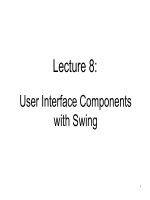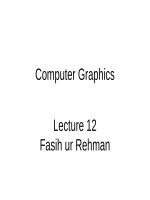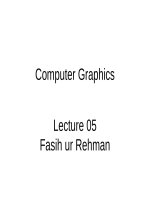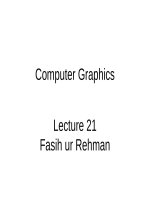Lecture Computer graphics: Lecture 8 - Fasih ur Rehman
Bạn đang xem bản rút gọn của tài liệu. Xem và tải ngay bản đầy đủ của tài liệu tại đây (78.85 KB, 16 trang )
Computer Graphics
Lecture 08
Fasih ur Rehman
Last Class
•
Ray Tracing
Today’s Agenda
•
Viewing
–
Perspectives
–
Projections
Viewing
•
Process of seeing a scene is regarded as
viewing.
–
The world or scenes are in three dimensions
(3D)
–
A 3D Scene has to be “projected” in 2D
–
A Synthetic camera has to be modeled
Viewing Problems
•
Where a viewer is located (Location)
•
Viewing Plane
•
The visible portion of the scene
–
•
•
i. e., what can be seen (clipping)
Maintaining relation between objects
–
Parallel lines
–
Angles
–
Distances
Relation to the viewer
Scenes and Objects
•
Viewing a scene or object
–
•
•
•
Some viewing techniques perform better in
viewing objects than a whole scene.
External Viewing: Viewing an object from
outside e. g. a building
Internal Viewing: viewing from inside. e.g.
internal of a building specially in games.
Projections
•
Project N-Dimensions Coordinates onto
Projections
•
When projection lines are parallel and
perpendicular to the image plane, the
resulting views are called orthographic.
Projections
•
The image plane is perpendicular to the
view direction, the projection is called
orthographic otherwise it is called oblique
Perspective
•
•
•
The process of creating 2D images of 3D
objects/scenes
In linear perspective, 3D objects are
projected onto an image plane in such a
way that straight lines in the scene
become straight lines in the image.
Parallel Projection: 3D points are mapped
to 2D by moving them along a projection
direction until they hit the image plane
View Classification
•
Parallel
–
–
Orthographic
•
Top (Plan)
•
Front
•
Side
•
Axiometric
Oblique
•
Cabinet
•
Cavalier
•
Other
Creating View
•
In three-point perspective, an artist picks
“vanishing points” where parallel lines
meet. Parallel horizontal lines will meet at
a point on the horizon. Every set of parallel
lines has its own vanishing points. These
rules are followed automatically if we
implement perspective based on the
correct geometric principles.
Computing Viewing Rays
•
•
•
•
We start by ‘shooting’ rays from the
camera out into the scene
We can render the pixels in any order we
choose (even in random order!), but we
will keep it simple and go from top to
bottom, and left to right
We loop over all of the pixels and generate
an initial primary ray (also called a camera
ray or eye ray)
The ray origin is simply the camera’s
Shadow Rays
•
•
•
•
•
Shadow rays behave slightly differently
from primary (and secondary) rays
Normal rays (primary & secondary) need
to know the first surface hit and then
compute the color reflected off of the
surface
Shadow rays, however, simply need to
know if something is hit or not
In other words, we don’t need to compute
any additional shading for the ray and we
don’t need to find the closest surface hit
This makes them a little faster than normal
Summary
•
Perspectives
•
Projections
References
•
•
Fundamentals of Computer Graphics Third
Edition by Peter Shirley and Steve
Marschner
Interactive Computer Graphics, A Topdown Approach with OpenGL (Third
Edition) by Edward Angel.









